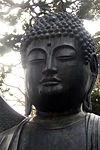
Robert Baker Dairyu Chotan Aitken Rōshi was a Zen teacher in the Harada-Yasutani lineage. He co-founded the Honolulu Diamond Sangha in 1959 together with his wife, Anne Hopkins Aitken. Aitken received Dharma transmission from Koun Yamada in 1985 but decided to live as a layperson. He was a socialist and anarchist who advocated social justice for homosexuals, women and Native Hawaiians throughout his life, and was one of the original founders of the Buddhist Peace Fellowship.

The Rinzai school, named after Linji Yixuan is one of three sects of Zen in Japanese Buddhism, along with Sōtō and Ōbaku. The Chinese Linji school of Chan Buddhism was first transmitted to Japan by Myōan Eisai. Contemporary Japanese Rinzai is derived entirely from the Ōtōkan lineage transmitted through Hakuin Ekaku (1686–1769), who is a major figure in the revival of the Rinzai tradition.
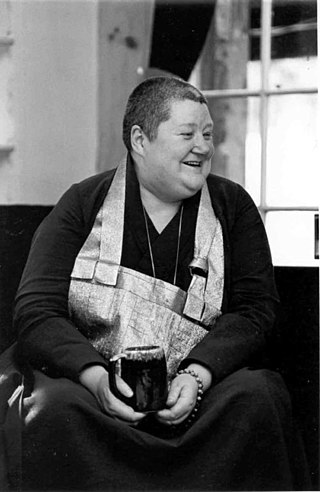
Hōun Jiyu-Kennett, born Peggy Teresa Nancy Kennett, was a British roshi most famous for having been the first female to be sanctioned by the Sōtō School of Japan to teach in the West.

Sanbo Kyodan is a lay Zen school derived from both the Soto (Caodong) and the Rinzai (Linji) traditions. It was renamed Sanbo-Zen International in 2014. The term Sanbo Kyodan has often been used to refer to the Harada-Yasutani zen lineage. However, a number of Yasutani's students have started their own teaching lines that are independent from Sanbo Kyodan. Strictly speaking, Sanbo Kyodan refers only to the organization that is now known as Sanbo-Zen International.
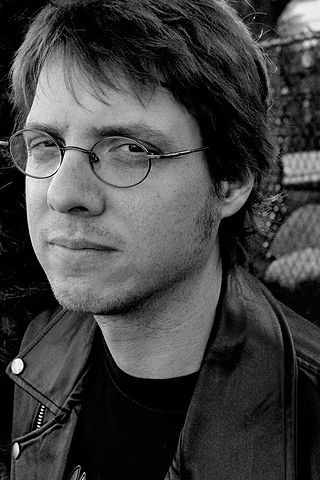
Brad Warner is an American Sōtō Zen teacher, author, blogger, documentarian and punk rock bass guitarist.

Hakuyū Taizan Maezumi was a Japanese Sōtō Zen Buddhist priest who substantially contributed to development of Zen in the USA.
Charlotte Joko Beck was an American Zen teacher and the author of the books Everyday Zen: Love and Work and Nothing Special: Living Zen.

Bernie Glassman was an American Zen Buddhist roshi and founder of the Zen Peacemakers, an organization established in 1980. In 1996, he co-founded the Zen Peacemaker Order with his late wife Sandra Jishu Holmes. Glassman was a Dharma successor of the late Taizan Maezumi-roshi, and gave inka and Dharma transmission to several people.
Shinge-shitsu Roko Sherry Chayat is the former abbot of the Zen Studies Society, based at the International Dai Bosatsu Zendo Kongo-ji monastery, outside Livingston Manor, NY, and at the New York Zendo Shobo-Ji on the Upper east Side of Manhattan. She is also the abbot of the Zen Center of Syracuse Hoen-ji. Chayat is an advocate for the use of meditation in medical settings, with Hoen-ji running the program Well/Being Contemplative Practices for Healing for healthcare professionals.

Hakuun Yasutani was a Sōtō priest and the founder of the Sanbo Kyodan, a lay Japanese Zen group. Through his students Philip Kapleau and Taizan Maezumi, Yasutani has been one of the principal forces in founding western (lay) Zen-practice.
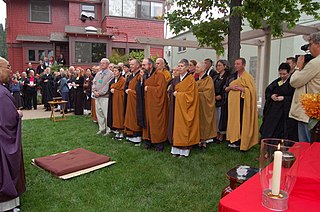
White Plum Asanga, sometimes termed White Plum Sangha, is a loose "organization of peers whose members are leaders of Zen Communities in the lineage of Hakuyu Taizan Maezumi," created by Hakuyu Taizan Maezumi and Tetsugen Bernard Glassman. It consists of Maezumi's Dharma heirs and subsequent successors.

Dr. Soyu Matsuoka, along with Sokei-an and Nyogen Senzaki, was one of the early Zen teachers to make the United States his home.

Robert Edward Kennedy is an American Jesuit priest, professor of theology, psychoanalyst and Zen rōshi in the White Plum lineage.

Upaya Institute and Zen Center is a center for residential Zen practice located in Santa Fe, New Mexico, and founded by Joan Halifax Roshi. The center focuses on integration of Zen practice with social action, with traditional cultivation of wisdom and compassion in the Buddhist sense. It also provides service in the areas of death and dying, prison work, environment, women's rights and peace work. According to the Upaya website, in 2002 Joan Halifax founded the Prajna Mountain Buddhist Order. A non-profit organization, Prajna is a new Buddhist Order in the lineage of Taizan Maezumi Roshi, the Zen Peacemaker Order and White Plum Asanga.

Kōbun Otogawa was an American Sōtō Zen priest.
Below is a timeline of important events regarding Zen Buddhism in the United States. Dates with "?" are approximate.
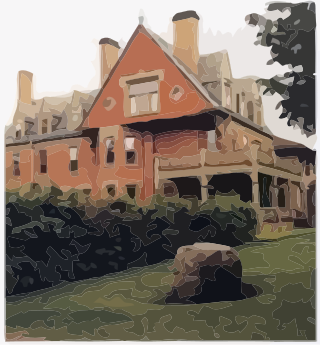
The phrase Zen center was coined by American students of Shunryu Suzuki in the mid-twentieth century, and the San Francisco Zen Center became the first Zen center, incorporating in 1962. Neither temples nor monasteries, Zen centers occupy a unique place in the historical development of Zen Buddhism and of Buddhism in the United States.
The Zen Peacemakers is a diverse network of socially engaged Buddhists, currently including the formal structures of the Zen Peacemakers International, the Zen Peacemaker Order and the Zen Peacemaker Circles, many affiliated individuals and groups, and communities formed by Dharma Successors of Roshi Bernie Glassman. It was founded by Bernie Glassman and his second wife Sandra Jishu Holmes in 1996, as a means of continuing the work begun with the Greyston Foundation in 1980 of expanding Zen practice into larger spheres of influence such as social services, business and ecology but with a greater emphasis on peace work. Eve Marko, Bernie Glassman's third wife, is a founding teacher of the Zen Peacemaker Order. Zen Peacemakers have developed from the White Plum Asanga lineage of Taizan Maezumi.
Zen was introduced in the United States at the end of the 19th century by Japanese teachers who went to America to serve groups of Japanese immigrants and become acquainted with the American culture. After World War II, interest from non-Asian Americans grew rapidly. This resulted in the commencement of an indigenous American Zen tradition which also influences the larger western (Zen) world.
Zen lineage charts depict the transmission of the dharma from one generation to another. They developed during the Tang dynasty, incorporating elements from Indian Buddhism and East Asian Mahayana Buddhism, but were first published at the end of the Tang.


